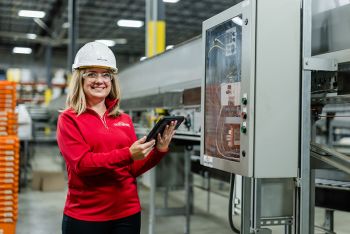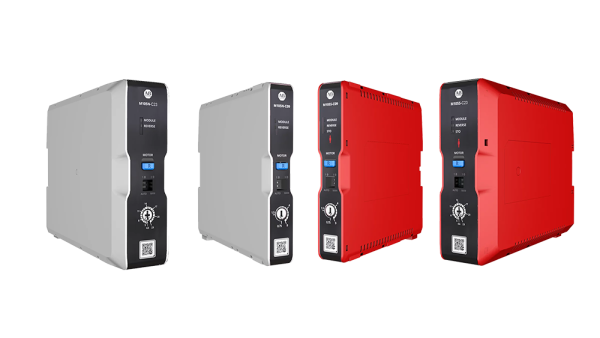The Complete Guide to the New M100 Electronic Motor Starter
- October 16, 2025
- Best Practices
- Automation
Outer space might be infinite, but panel space is not. What solutions are OEMs using to optimize control panel space?

With a 78% reduction in required panel space and 56% less wiring cost, the new M100 electronic motor starter from Rockwell Automation allows OEMs to simplify designs and streamline machine builds for more functionality, less clutter and out-of-this-world performance. This space-saving, all-in-one device integrates a contactor and overload relay into a single, streamlined unit.
Want to better understand how it works? Compare the M100 vs. traditional motor starters, and get the answers to some frequently asked questions below.
Why Choose an Electronic Motor Starter?
Traditional motor starters typically consist of two separate components: a contactor and an overload relay. The M100 electronic motor starter combines both into one compact device, reducing the number of components you need to order, install, and maintain.
Key Benefits:
- Integrated contactor and overload protection
- Built-in safety features like Safe Torque Off (STO)
- Remote control and performance monitoring
- Compact footprint for panel optimization
Comparing the M100 vs. Traditional Motor Starters:
| Feature | M100 Electronic Motor Starter | Traditional Motor Starter |
|---|---|---|
| Size Range | 9A – 23A | 9A – 2650A |
| Integrated Overload Relay | ✅ | ❌ |
| Removable Terminal Blocks | ✅ | ❌ |
| Compact Footprint | ✅ | ❌ |
| Point-on-Wave (PoW) Switching | ✅ | ❌ |
| All-in-One Safety & Reversing | ✅ | ❌ |
| High Frequency Applications | ❌ | ✅ |
Frequently Asked Questions About the M100 Motor Starter
What’s the advantage of electronic motor starters?
Traditional motor starters consist of two separate components, the contactor and overload relay, but an electronic motor starter is a completed device with both the contactor and the integrated overload.
Using the M100 streamlines the components you need to order, manage and maintain. With performance monitoring, remote control, firmware updates and built-in safety features, the M100 offers more functionality with a similar or reduced footprint.
What can the M100 replace in my panel?
Depending on the type of application, you can use the M100 instead of traditional starters and reversing applications. Instead of ordering a separate contactor and overload relay, the M100 motor starter combines the function of both.
Is the M100 a direct replacement for my contactor and overload relay?
The M100 has its place in certain applications, but it is not a direct replacement for your traditional contactor and overload relay. For high frequency applications with a high cycle count and/or heavy load, a traditional contactor and overload will be more durable and efficient.
What makes the M100 a more flexible solution?
The M100 series can be used for single-phase or three-phase applications and has non-reversing, reversing, safety and standard options, all with the same slim form-factor. In temperatures up to 55º C (131º F), they can be installed side-by-side without derating, or “zero stacked,” which provides a significant reduction in the required panel space.
It also has Point-on-Wave switching technology. It opens one of the phases at the zero-volt sine wave and then the other two contacts, which keeps the arc to a minimum while opening the contact under load. It lessens wear on the contacts and keeps thermals down inside the control panel to reduce equipment aging and improve reliability. What are some safety benefits of the M100?
The M100 can achieve a PLd safety performance level with a safety device wired directly to it, which eliminates the need for a separate safety relay or contactor. It offers a Safe Torque Off (STO) option that electrically prevents a motor from generating torque. This makes it safe for maintenance personnel to operate without fully disconnecting the power.

Where can I use the M100 instead of a contactor and overload relay?
In applications where space is limited, you can save significant space using the M100 instead of a contactor and overload. That’s especially true if you are replacing reversing contactors. A traditional reversing application typically requires two full-sized, interlocked contactors, taking up at least 90mm of panel space on the DIN rail. The M100 simplifies this setup. The 9A version replaced the 90mm-wide reversing starter in just 22.5mm of space, while the 23A version does it in only 45mm, cutting the required space in half.
The M100 works best in low frequency starting and stopping applications like fans, conveyors and pumps. The zero stack capabilities with no derating up to 131F, Point-on-Wave technology and the built in STO safety option make these a valuable component that can be used for applications and industries like these:
- Material handling
- Agriculture
- Automotive
- HVAC
What sizes are available? What do you do if you need something larger?
At this time, the M100 is only available in 9A or 23A. If you need something larger, you should use the traditional 100C/100E contactor and overload combination. With the 100E line, you can get contactors rated up to 2,650 amps.
How big is an M100 series starter vs. a contactor with overload protection?
The 9A M100 module is only 22.5mm wide, which is half the width of the 23A M100 module or a 100C/100E 23A contactor. The 23A M100 module is 45mm wide, which is identical to the 100C/100E 23A contactor.
Both modules are about the same height as a 100C contactor with an E100 overload relay. This makes it an easy replacement for most applications if there is an existing contactor and overload in the same spot.
How does the M100 simplify wiring?
The M100 comes with removable terminal blocks (screw type or push-in), so you can complete all control, power and safety wiring offline before installing. If you need to replace a device, you can do so without any unwiring.
Integrating the contactor and overload together plus integrating multiple functions into a single device reduces the footprint of the panel and simplifies the design for quicker installation and maintenance.
Can it fit into my existing applications?
The M100 will stick out further (deeper) than your 100C or 100E contactor, but the width is either the same (23A) or half the width (9A), and height is the same.
SEE THE M100 ELECTRONIC MOTOR STARTER FOR YOURSELF
Now that you’re familiar with the new M100 motor starter, would you like to see it firsthand? Schedule a product demo with one of our smart devices specialists to get a feel for the design and how it could help your panel optimization efforts.
Ready to optimize your panel with the M100 electronic motor starter?
Schedule a demo

ARTICLE BY:
BRETT BARKER
EMPLOYEE-OWNER, SMART SOLUTIONS SPECIALIST